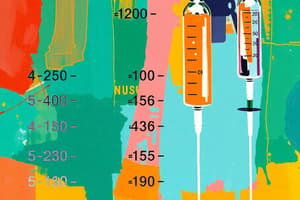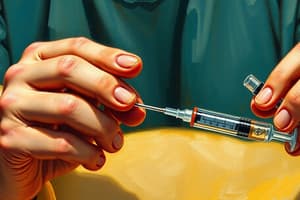Podcast
Questions and Answers
95Kg equals how manypounds?
95Kg equals how manypounds?
- 209 (correct)
- 220
- 43
- 190
You are to give a patient 1.6 mg of narcan, your narcan on hand is 2 mg per 2ml. How many mL will you give?
You are to give a patient 1.6 mg of narcan, your narcan on hand is 2 mg per 2ml. How many mL will you give?
- 2
- 1.6 (correct)
- 1
- 1.5
You are going to give a patient Ketorolac 25mg, it is supplied in 30mg per 1 ml how many mL are you going to give?
You are going to give a patient Ketorolac 25mg, it is supplied in 30mg per 1 ml how many mL are you going to give?
- 0.5
- 0.7
- 0.6
- 0.8 (correct)
What is the first step in drug dosage calculations for IV administration?
What is the first step in drug dosage calculations for IV administration?
When converting a dose to match a new concentration, what should be done if the drug vial contains 8 mg/mL and the desired final concentration is 4 mg/mL?
When converting a dose to match a new concentration, what should be done if the drug vial contains 8 mg/mL and the desired final concentration is 4 mg/mL?
For heparin administration, what is used as the unit of measurement for dosing?
For heparin administration, what is used as the unit of measurement for dosing?
How would you calculate the initial dose of heparin for a 60 kg patient if the dose is 4500 U/kg?
How would you calculate the initial dose of heparin for a 60 kg patient if the dose is 4500 U/kg?
When administering heparin, what factor should be taken into account for dosage adjustments?
When administering heparin, what factor should be taken into account for dosage adjustments?
In IV drug administration calculations, why is it important to round the calculated volume to the nearest whole milliliter?
In IV drug administration calculations, why is it important to round the calculated volume to the nearest whole milliliter?
What is the primary purpose of IV administration?
What is the primary purpose of IV administration?
In IV drip rate calculation, why is it important to choose an IV set with a suitable drip chamber volume?
In IV drip rate calculation, why is it important to choose an IV set with a suitable drip chamber volume?
What is the drip rate unit typically used when expressing IV drip rates?
What is the drip rate unit typically used when expressing IV drip rates?
Why is precision and accuracy in IV dosing crucial for patient care?
Why is precision and accuracy in IV dosing crucial for patient care?
What is a critical consideration when administering heparin intravenously?
What is a critical consideration when administering heparin intravenously?
What is one of the key ethical dilemmas that paramedics face in emergency care, as mentioned in the text?
What is one of the key ethical dilemmas that paramedics face in emergency care, as mentioned in the text?
Which of the following is an example of effective communication described in the text?
Which of the following is an example of effective communication described in the text?
Why is continual learning and development important for paramedics?
Why is continual learning and development important for paramedics?
When faced with a patient expressing suicidal ideation, paramedics must prioritize:
When faced with a patient expressing suicidal ideation, paramedics must prioritize:
Which of the following statements best describes the role of communication in paramedicine?
Which of the following statements best describes the role of communication in paramedicine?
How do ethical dilemmas in emergency care impact paramedics' decision-making process?
How do ethical dilemmas in emergency care impact paramedics' decision-making process?
What is the primary reason paramedics need to develop a wide-ranging differential diagnosis skill set?
What is the primary reason paramedics need to develop a wide-ranging differential diagnosis skill set?
Why is it important for paramedics to consider a broad spectrum of conditions in their initial differential diagnosis process?
Why is it important for paramedics to consider a broad spectrum of conditions in their initial differential diagnosis process?
In an emergency situation, why should paramedics refine their differential diagnosis based on information like medical history and physical examination findings?
In an emergency situation, why should paramedics refine their differential diagnosis based on information like medical history and physical examination findings?
Why do paramedics need to continually communicate with patients and team members during emergency care?
Why do paramedics need to continually communicate with patients and team members during emergency care?
What role do ethical dilemmas play in the work of paramedics?
What role do ethical dilemmas play in the work of paramedics?
How can a paramedic's ability to navigate ethical dilemmas positively impact patient care?
How can a paramedic's ability to navigate ethical dilemmas positively impact patient care?
Flashcards
IV administration
IV administration
Delivering liquid medication, hydration, or nutrients directly into the bloodstream.
IV drip rate
IV drip rate
The flow of IV solution into a patient's vein, measured in drops per minute (DPM) or milliliters per hour (mL/h).
Drip rate calculation
Drip rate calculation
Determining how fast to deliver IV fluids, considering volume and time.
IV dosage calculation
IV dosage calculation
Signup and view all the flashcards
Heparin
Heparin
Signup and view all the flashcards
Heparin dosage calculation
Heparin dosage calculation
Signup and view all the flashcards
Paramedicine
Paramedicine
Signup and view all the flashcards
Differential Diagnosis
Differential Diagnosis
Signup and view all the flashcards
Ethical Dilemmas in Emergency Care
Ethical Dilemmas in Emergency Care
Signup and view all the flashcards
Patient Communication
Patient Communication
Signup and view all the flashcards
Continual Learning
Continual Learning
Signup and view all the flashcards
Drug Dose Determination
Drug Dose Determination
Signup and view all the flashcards
Desired Concentration Conversion
Desired Concentration Conversion
Signup and view all the flashcards
Volume Calculation
Volume Calculation
Signup and view all the flashcards
Volume Rounding
Volume Rounding
Signup and view all the flashcards
Study Notes
IV Administration and Dosage Calculations
- IV administration is a critical medical technique that delivers liquid medication, hydration, or nutrients directly into the bloodstream.
- Precise IV dosing is crucial for effective treatment, avoiding side effects, and preventing harm to the patient.
IV Drip Rate Calculation
- IV drip rate refers to the flow of a solution from an IV bag into the patient's vein.
- Drip rate is typically expressed in drops per minute (DPM) or milliliters per hour (mL/h).
- To calculate the drip rate, follow these steps:
- Determine the desired rate: Decide on the desired volume of fluid per hour the patient needs.
- Select a compatible IV set: Choose an IV set with a suitable drip chamber volume that divides evenly into the desired rate.
- Calculate the drip rate: Divide the total volume of the drip chamber by the time it takes to empty.
Dosage Calculations
- Accurate IV dosage calculations are essential for maintaining patient safety and efficacy.
- Drug dosage calculations primarily involve four steps:
- Determine the correct drug dose: Consult the appropriate medical literature or drug reference guide to find the correct dose for the patient's condition and weight.
- Convert the dose to the desired concentration: If the drug comes in a vial with a different concentration than the desired final concentration in the IV bag, convert the dose to match the new concentration.
- Calculate the volume: Multiply the converted dose by the volume of fluid in the IV bag.
- Round the volume: Round the calculated volume to the nearest whole milliliter and add a small volume buffer, usually 1-2 mL, to account for any errors or residual drug in the syringe or IV set.
Heparin Administration
- Heparin is an anticoagulant that belongs to a class of medications called anticoagulants (blood thinners).
- Heparin dosages are typically calculated as a unit per kilogram (U/kg) of body weight, with adjustments necessary for various patient factors.
- Calculate the initial dose: Multiply the patient's weight in kilograms by the appropriate dose per kilogram.
- Calculate the continuous infusion rate: Divide the initial dose by the desired duration of the heparin infusion.
- Adjust the dose: Regularly monitor the patient's activated partial thromboplastin time (aPTT) and adjust the heparin dosage as needed.
Paramedicine
- Paramedicine is a critical field that combines emergency medical care with rapid transportation to advanced healthcare facilities.
Differential Diagnosis
- Paramedics must develop a wide-ranging differential diagnosis skill set to ensure they accurately identify and manage a variety of medical conditions.
- Differential diagnosis involves considering multiple potential causes for a patient's symptoms, starting with the most common and moving towards the rarest.
Ethical Dilemmas in Emergency Care
- Paramedics face numerous ethical dilemmas in emergency care, from patient confidentiality to scope of practice.
Communication with Patients and Healthcare Team
- Effective communication is vital for paramedics to deliver high-quality care.
- Paramedics must accurately capture the patient's medical history, symptoms, and vital signs, which they then communicate to receiving healthcare teams and other colleagues.
Continual Learning and Development
- Paramedics must continually update their knowledge and skills to remain current with best practices and emerging trends in the field.
Studying That Suits You
Use AI to generate personalized quizzes and flashcards to suit your learning preferences.



